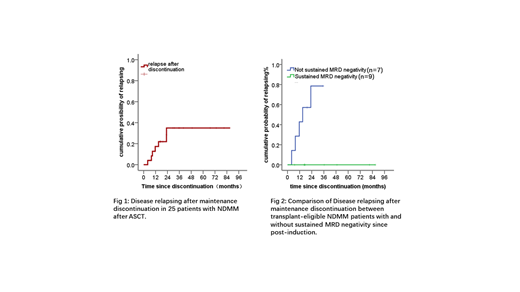Abstract
Background: Multiple myeloma is still an uncurable plasma cell malignancy. Maintenance plays an important role in the MM therapy for decreasing the probability of disease progression. However, prolonged maintenance therapy inevitably brings economic burdens and toxicities to the patients and families. Minimal residual disease (MRD) directed maintenance discontinuation might balance the disease progression and the toxicities. This study aimed to compare the risk of disease progression after maintenance discontinuation between transplant-eligible patients with and without achieving sustained MRD negativity for at least 2 years since post-induction.
Methods: One hundred and fifty-seven consecutive patients with newly diagnosed multiple myeloma who had received bortezomib based induction and subsequent single autologous stem cell transplant (ASCT) between 2008 and 2018 in our institute were enrolled. Patients discontinued maintenance was identified during regular follow-up. These patients were then follow-up every 6-12 months until disease progression.
Results:
Twenty-five patients discontinued their maintenance therapy at the median of 29.3 months post-transplant because of intolerability. For these 25 patients, the median age was 50 years old (range 35-68), and 19 (76%) were male and 6 (24%) were female. The frequencies of IgG, IgA, IgD and light-chain-only subtype of MM were 6 (24.0 %), 7 (28.0 %), 1 (4.0 %) and 11 (44.0 %) patients, respectively. There were 10 (40.0 %), 7 (28.0 %), 8 (32.0 %) patients with ISS stages of 1, 2, and 3, respectively. High-risk iFISH was defined as 17p deletion-positive and/or t (4;14)-positive and/or t (14;16)-positive. Fifteen (60.0 %), four (16.0 %) and six (24.0 %) patients had high-risk, standard-risk and missing iFISH, respectively.
With the median follow-up time of 25.4 months after discontinuation, the cumulative disease progression rate was 35%±11% at 2 years after discontinuation (Fig1). Among the 16 patients who had received MRD monitoring since post-induction and thereafter every 3-6 months, 9 achieved sustained MRD negativity since post-induction and maintained for at least 2 years after the transplant. None of these 9 patients had disease progression.
No significant difference on age, sex, ISS staging, LDH level and high-risk cytogenetic rate was found between patients with and without sustained MRD negativity. The log-rank analysis showed that patients achieving sustained MRD negativity for at least 2 years since post-induction had significantly lower 2-year disease progression rate after maintenance discontinuation (0% vs. 78.6±17.8%, median time to PD since discontinuation were not reached vs. 14.3 months, as shown in Fig 2).
Conclusion: sustained MRD negativity since post-induction and maintained at least 2 years after transplant might predict successful maintenance discontinuation in patients with transplant-eligible NDMM.
No relevant conflicts of interest to declare.


This feature is available to Subscribers Only
Sign In or Create an Account Close Modal